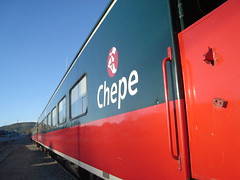
By David Agren/Special to The Herald Mexico
El Universal
Martes 27 de marzo de 2007
MATAMOROS, Tamps. - Cab driver Mario Hinojosa and his sidekick Don Enrique operate from a two-car taxi stand in Matamoros´ Historic Center. They normally shuttle locals and tourists around the border city in a new compact sedan and an aging, yellow 1976 Ford with so many miles that Don Enrique can´t remember how many times the odometer has turned over.
Most of the tourists they serve are daytrippers, who cross the Rio Bravo from neighboring Brownsville, Texas, in search of low-rent diversions like cheap boozing and poring over trinkets.
But a few of the visitors, curious about the dark side of the border, inquire about narcoturismo (drug-trafficking tourism) - which involves visiting the sites where traffickers carried out their dirty deeds and eventually flamed out in battles with law enforcement officials.
"People come here asking about tours all the time," Hinojosa said on a quiet Monday morning, adding that he charges US$60 for narco-inspired excursions.
With drug cartel violence rife in many destinations frequented by foreigners - the northern border region, and resort areas like Acapulco and Mazatlán - some enterprising taxi drivers are cashing in on tourists´ morbid curiosity, leading informal tours to once-blood-soaked locales made infamous during the ongoing war on drugs.
While not well publicized, taxi drivers in Matamoros, a city of 450,000, report fielding queries about jaunts to the neighborhood where former Gulf cartel boss Osiel Cárdenas Guillén was apprehended.
They´ve also taken passengers to Santa Elena, the site of a ranch that was home to a group of narcosatánicos (narco-Satanists) under the sway of Cuban-American drug kingpin Adolfo de Jesús Constanza - people that Hinojosa said "had a screw loose." (The narcosatánicos carried out ritual sacrifices and smuggled marijuana until they were busted in 1989.)
Thankfully for Matamoros, the worst of its brushes with narco-violence appears to be past - unlike Nuevo Laredo, which still suffers from ongoing turf battles and assassinations.
Many taxi drivers said tourists have little to worry about, but they also cautioned that problems still linger out of sight.
"If you don´t get involved in (the drug-trafficking) business, you won´t have any problems," Mario Hinojosa said.
On the eve of spring break, Matamoros seemed placid and tidy, spare the drunken yahoos in oversized sombreros heading back to Brownsville after a night on the town. The tourist office proudly promotes the Mercado de Juárez, nearby Playa Bagdad and the well-curated Museo de Arte Contemporáneo de Tamaulipas.
But when asked of the existence of narcoturismo in Matamoros, an official at the state tourism office expressed horror - as if such things would ever occur in her hometown - and declined comment.
Tour guide Santiago Villanueva, who operates out of a green-and-white maintenance shed on the main drag coming from the border crossing, scoffed at the suggestion in a Grupo Reforma story that narcoturismo was popular in Matamoros. Brandishing a union-issued credential and wearing a green cap that read: "Tour Guide," he emphatically called the article "Mercadotecnia"(Marketing) - scribbling the word in bold letters above a copy of the story. While he didn´t deny the presence of narcoturismo, he said such stories were just a scheme to lure the wrong kind of tourism into Matamoros.
"It´s not just a problem here, but all over the world," he added, pointing to the Branch Davidian compound in Waco, Texas, scene of a botched 1993 raid, as a notorious place that attracts visitors.
Just up the street from Villanueva´s shed, Taxi driver Alfonso Tirado sometimes gives narco tours, but not as often as before. He failed to see the appeal of such trips.
"You can go, but there´s nothing to see out there ... maybe a few crosses," he said, explaining that Santa Elena is mostly abandoned and overgrown with weeds.
He also defended Matamoros as a reasonably safe spot to visit during the daytime.
"If you go to Ciudad Juárez [a border town where more than 300 women have been murdered since 1993] you won´t see people walking around like here," he commented.
Fewer tourists are coming to Matamoros than previously, according to most taxi drivers, although some thrillseekers are now asking about different novelty tours - like a trip to the wrong side of the tracks.
"They often want to see the poor barrios," Mario Hinojosa explained. They don´t believe such poverty really exists."
It sadly does exist - just like narcoturismo.
UPDATE: A short version of this also ran in The Globe and Mail.







